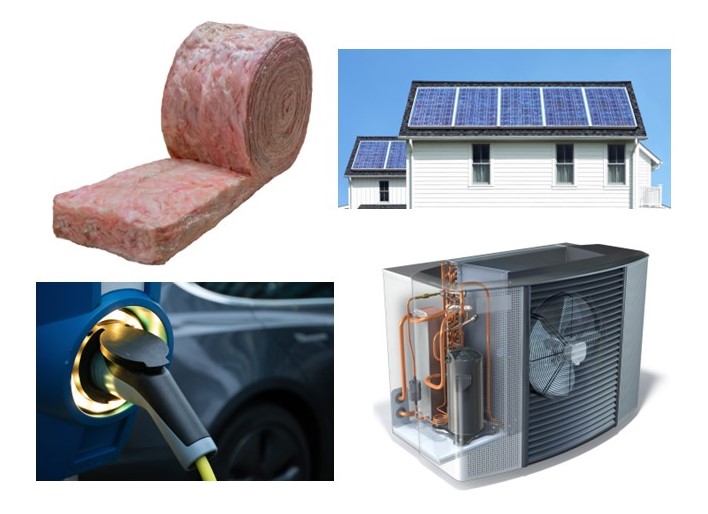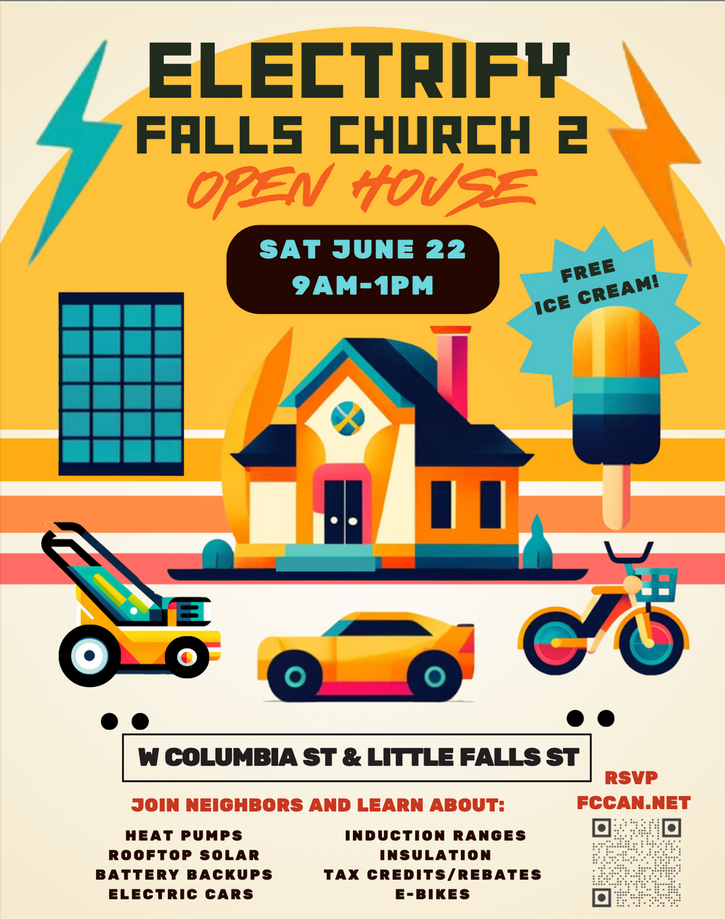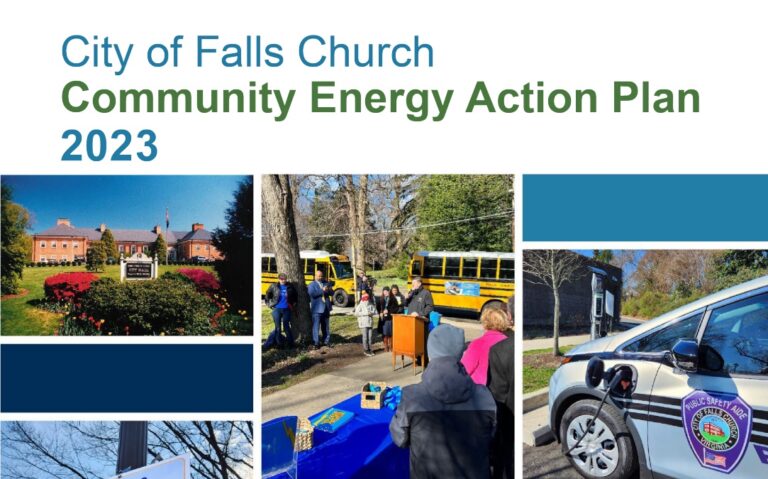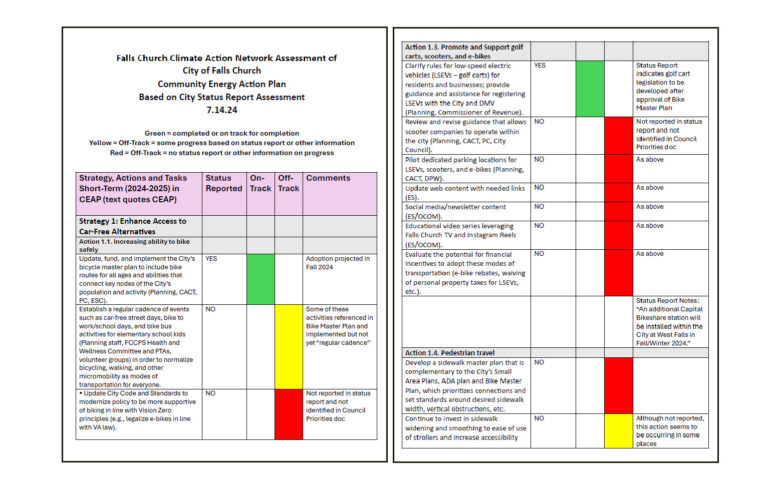FCCAN: New Local Group Shows How We Can Respond to Climate Change by Cutting Greenhouse Gases
By Jon Ward, Jeff Peterson and David Stile, FCCAN
FCCAN Event
There will be an open house ‘Electrify Falls Church’ event this Saturday, June 22, from 9 -1 at a City residence. This is a chance to talk with neighbors about steps they’ve taken to reduce their use of fossil fuels and save on energy costs (rooftop solar, electric vehicles, heat pumps and more).
Meet at the corner of Little Falls Street and W Columbia Street, or register at https://fccan.net/electrify-rsvp to receive an exact address and more details in advance.
Introducing FCCAN
The Falls Church Climate Action Network (FCCAN) is a group of Falls Church residents promoting steps to reduce release of greenhouse gases that cause climate change. FCCAN provides information on steps that people and businesses can take to cut their emissions and (b) advocates for City of Falls Church actions to reduce emissions from city operations and the community more generally. You can learn more information about FCCAN or join the FCCAN e-mail list by going to https://fccan.net/.
In 2023, the City Council reaffirmed its goal that community-wide emissions in 2030 be reduced at least 50% below 2005 levels and eliminated by 2050. The Council adopted a Community Energy Action Plan, which describes potential pathways to achieve the 2030 goal. The plan also recommends a One-Stop Shop to help residents navigate many of the actions discussed below.
In this post, FCCAN members Jon Ward, Jeff Peterson, and David Stile provide background on the climate change problem and outline steps people can take to reduce greenhouse gas emissions. Links to useful websites are included throughout.
Climate pollution in Falls Church
There is scientific consensus that civilization must rapidly reduce its greenhouse gas (GHG) emissions, mainly carbon dioxide (CO2), to avoid accelerated reshaping of the planet’s habitability. And “rapidly” means “within the next 7 to 10 years.” Major changes in infrastructure and broad government action are inherently slow. So, as individuals and businesses, where should we focus our efforts while the big institutions make their major, long-lead-time changes?
This article addresses “How to Cut Our Local Greenhouse Emissions,” which are roughly half of our share of total emissions. A later article will address the harder-to-measure but equally important non-local GHGs emitted to produce and deliver the things we buy.
The pie chart below shows the City’s local GHG inventory for 2018, the most recent non-pandemic year for which data are available.

The small “Other” category includes leaks of natural gas and refrigerants; waste; and adverse land use. Trees capture and store carbon, and accounting for this benefit from all our trees would reduce the size of the pie by about 2%. About 97% of these local emissions are from residents and businesses, with only about 3% due to operations of local government and the school system. Clearly, local residents and businesses play an important role in implementing near-term actions, while we rely on the Virginia and federal governments to force Dominion Energy and new vehicles to use less fossil fuel.
What can residents do at home?
There is no one-size-fits-all recommendation. It depends on the condition of your residence. And renters may require landlord approval before making improvements. We suggest a three-tier approach:
- Improve what you have.
- Replace appliances with all-electric, higher efficiency versions.
- Install solar panels.
If the options below seem overwhelming, a professional home energy assessment can help you prioritize them (assessment costs may range from low-cost to a few hundred dollars, with the more expensive ones providing more detailed recommendations).
1. Improve what you have
Maybe you have made the behavioral and other basic changes:
- tossed all your old incandescent Edison light bulbs and converted to LED lighting.
- set the thermostat colder in winter and warmer in summer.
- hang-dried laundry whenever practical.
- turned off lights and TVs when not in use.
- avoided using the ‘Heated Dry’ function on your dishwasher, or at least set it to run between 2:00 and 4:00am when the electric grid is almost always providing some of its lowest-CO2 power, and
- hunted down vampire loads. These are electronics that consume electricity even when they are turned off. These can include hairdryers, cable TV boxes, DVRs, printers, fax machines, and anything that can be turned on using a remote control.
Even if you already use a programmable thermostat, curtains to block the summer sun, and ceiling fans to better distribute room air, chances are heating and air-conditioning are still your largest users of energy. Your walls and windows are what they are, but you can lose significant energy through fixable air leaks, as shown in the figure below.
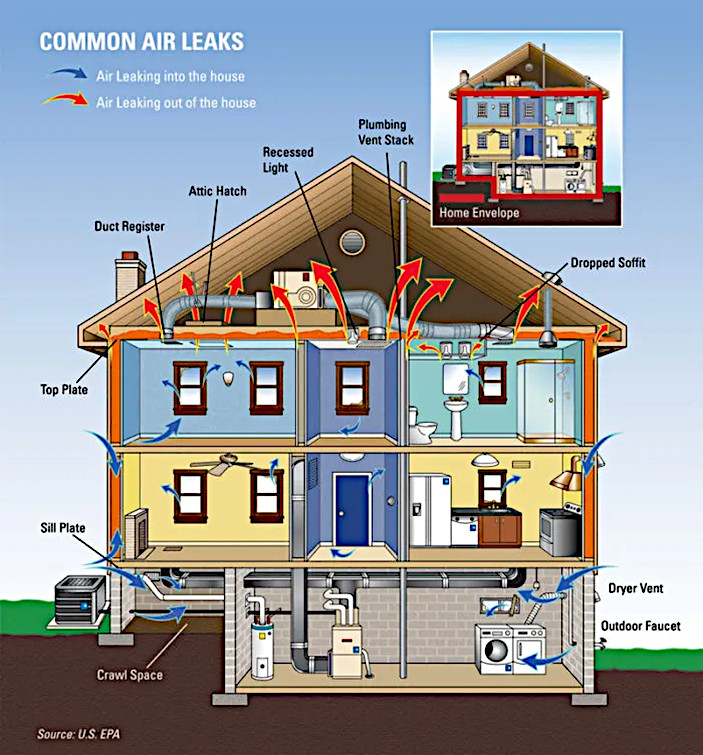
There are lots of lists out here, but here’s one list of ways to seal air leaks in your home. It’s where some D-I-Y time with weatherstripping, caulk, and spray foam can really pay off. A home energy assessment can estimate the benefits as well as the cost of someone else doing these fixes for you.
2. Upgrade appliances and go all-electric
First, when it’s time to replace an appliance, go with products that have the Energy Star label. This can reduce energy use by at least 15% vs. the minimum federal standard. A search of Lowes.com shows that only about half of their 20 top-selling dryers and refrigerators are Energy Star certified, so compare “EnergyGuide” labels among the models you’re considering.
Never discard refrigerators, freezers, air conditioners or dehumidifiers at the City’s metal recycling lot; the refrigerants are usually potent greenhouse gases requiring professional disposal. Retailers almost always provide take-away services when delivering new appliances. Also, some refrigerators are advertised as “garage ready.” This only means they CAN operate in high temperatures (e.g., 110⁰F); they will still, however, be very inefficient in hot environments like a garage.
Second, in the pie chart above, roughly half the residential emissions are due to natural gas, and gas accounts for about 15% of Falls Church’s total greenhouse gas emissions. When the City looked at how best to achieve even partial GHG reductions, it identified both energy efficiency and eliminating the use of natural gas in space and water heating.
The key to reducing natural gas use is: BE PROACTIVE. Gas water heaters last 10-12 years, gas furnaces 15-20 years. And when they fail people tend to replace them ASAP, without shopping for cleaner and more efficient alternatives. Replacing like-with-like gas appliances locks homes into fossil fuel use for another decade or more.
So, if your gas appliances are getting old, be proactive. Start planning today by taking advantage of tools like Rewiring America’s Electrification planner to get a better understanding of what is required and the tax incentives available. Also, reach out to FCCAN to be connected with a local volunteer electric coach to guide you through the electrification process!
The City has a “One Stop Shop” webpage to help local residents with all the questions that arise as part of reducing energy use and greenhouse gas emissions from homes, including costs of options and available tax credits. This page is continually updated.
3. Install rooftop solar
The steps above can reduce total home energy use by 5%, 20%, maybe 35% depending on how old and inefficient the home currently is.
Shifting to electric energy is a big step forward, but a lot of our electric power is still from fossil fuel sources. So, to fully decarbonize your electricity use, Dominion Energy customers have only one real option today: rooftop solar.
Rooftop solar is a big investment ($10,000 to $25,000 typically), but the energy you produce earns you credits on your Dominion Energy bill through “net metering,” which is how you recoup your investment over time. The City’s webpage (https://fallschurchva.gov/2258/Rooftop-Solar) has some useful info, and FCCAN has a list of local owners happy to share their experiences with you.
There is also a permitting process that the solar installer is responsible for. The cost of permits is $100 to $150.
Northern Virginia has two programs to help homeowners navigate rooftop solar and get bigger discounts with vetted installers. They are:
Federal tax credits of 30% of installation costs are available.
If you are annoyed that rooftop solar is your only real option to slash your electricity carbon footprint, the best response is to get active and get loud, because Dominion’s lobbyists in Richmond keep winning in their efforts to stifle consumer choices.
How can residents reduce emissions from transportation?
There are roughly 13,000 vehicles registered in the City. If each is replaced every 13 years, that’s 1,000 vehicle decisions a year. By 2035, we could have mostly clean vehicles on the roads. But each decision must go the right way.
Right now, well before your next vehicle decision, implement the steps in the figure below, starting with #1 and working down.
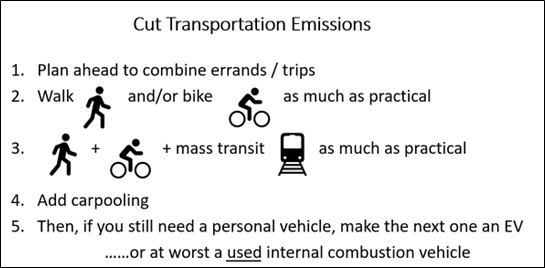
Consider whether you would bike farther, or to work, or to Metro, if it weren’t for exerting up those hills or you didn’t have so much to carry? Maybe an e-bike or an e-cargo-bike would be a way to reduce those shorter car trips.
And remember, ride-hailing with Uber or Lyft does NOT count as carpooling or transit; whatever your trip length, someone not only drove you, they also drove to come pick you up.
After a year, check your maintenance records to see how many miles each vehicle actually went in a year. If it’s under 4,000 mi/yr or so, but you need to replace it, consider a used gas vehicle and put the saved money into other efficiency measures. Your carbon footprint will still be similar to someone who drives a fully electric vehicle (battery EV or BEV) 10,000 mi/yr (our electricity still comes mostly from fossil fuels).
Purchasing a new vehicle
When you get to Step 5 and are ready to purchase a new vehicle, review the many options now available that are fully electric or partially electric (i.e., Plug-in Hybrid EVs [PHEV] that run on electricity for 20-40 miles and then switch to gas).
Most new fully electric vehicles have ranges well over 200 miles, but if you are still concerned about range, Plug-in Hybrids (PHEV) solve that issue. For low-mileage drivers, PHEVs have additional environmental benefits as discussed here.
The most important thing is NOT to buy or lease a NEW non-battery vehicle. Because even if you trade-in that NEW car soon and switch to an EV or PHEV, that new gas vehicle will still be out there, with someone else driving it around, puffing out CO2 for its full 100k+ miles. You may have heard the chant about fossil fuels, “Keep It In The Ground.” The same applies here for new non-battery vehicles: “Keep It On The Dealer’s Lot.”
New EVs may be eligible for tax credits of up to $7,500. Taxpayers filing as married must have an adjusted gross income of under $300k, single filers under $150k. If you don’t qualify or the EV you want isn’t eligible, consider leasing; the dealer can take a tax credit and pass the savings on to you.
A longer list of pre-owned EVs are also eligible for credits of up to $4,000. A used EV’s model year must be two years before the calendar year of the vehicle purchase, meaning that EVs from 2022 or earlier are now eligible. It must also have a sales price of $25,000 or less. The income limits are half of those for new EVs. To search for eligible EVs and learn more about the Clean Vehicle Credit, see FuelEconomy.gov/feg/tax2023.shtml.
If you expect you’ll qualify for the tax credit, some dealerships may be set up to offer the credit as a cash-on-the-hood discount at the time of sale, rather than your waiting until next year when you file your taxes. (This is a new option in 2024, and as of January, the only showroom in Falls Church with eligible new EVs, Koons Ford, was not set up for this.)
EV charging
The City’s “One Stop Shop” EV page has information to help local residents consider their EV charging options. The following information is from their webpage.
There are two ways to charge your EV at home: Level 1 Charging and Level 2 Charging.
- Level 1 Chargers (120V) plug into your house’s existing electrical outlets, using the cable that comes with the vehicle. These add about 4 to 5 miles of range per hour plugged in.
- Level 2 Chargers (240V) require a more powerful connection that may require changes to the electrical wiring in your home. These will give you upwards of 30 miles of range for every hour plugged in.
- If you do need a Level 2 Charger installed speak with a licensed electrician about your home’s needs. Your electrician will need to apply for an Electrical Permit for wiring changes.
- To help offset costs, Dominion Energy offers a $125 rebate for a Level 2 EV charger purchase and their Demand Response Program.
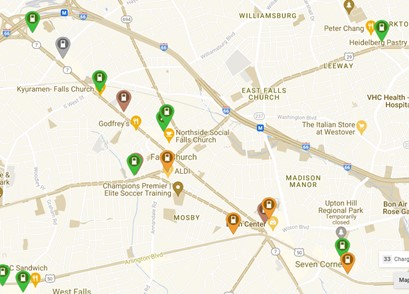
Editor’s Note: City Council approved the Community Energy Action Plan in November 2023. Read the Pulse post Energy Plan Includes Residential Zoning Changes For Greater Density .

